Touring Transsylvania and Wallachia
Grey-green hills and valleys with shining church steeples
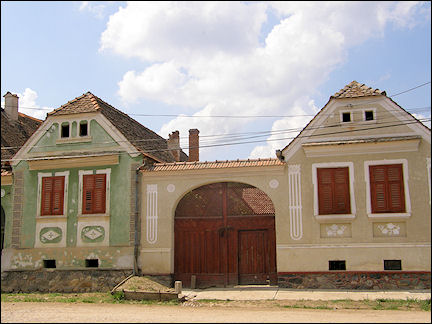
|
Touring the grey-green hills of Transsylvania and Wallachia. Domes of orthodox churches shine in the valleys. Horse-drawn carts are still a common means of transportation. Castles and fortresses are scattered over the landscape. There are often food stalls on the side of the road. The route goes from Nâdlac near the Hungarian border, to Alba Iulia, Târgu Mureş, Sighişoara, Biertan, Braşov, Piteşti, Sibiu and Şandra.
Travelogue & photos: Jan Noot
After a short stay in picturesque Mainbernheim, Germany and a few hot, sunny days in Hungary, we drive via Szeged to Nagylak on the Romanian border. The road leads through a hilly landscape with vast sunflower and corn fields.
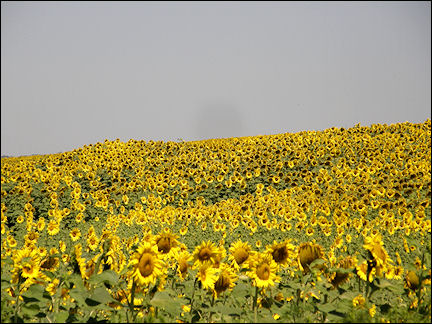
|
We are waved through on the Hungarian side of the border and drive a few meters in no man's land. On the Romananian side of the border we are stopped by robust customs officers, dressed in stern grey uniforms, including weaponry in a holster.
After a short look at our passports, without a look at the passengers in the car, we are gruffly ordered to drive on. We are in Romania, where Nagylak is called Nâdlac.
We drive to Arad and then take the road to Alba Iulia. Compared to Hungary the surroundings don't change much at first, but later the hills get higher and we see the even higher Western Transsylvanian Alps in the distance, in many shades of grey-green.
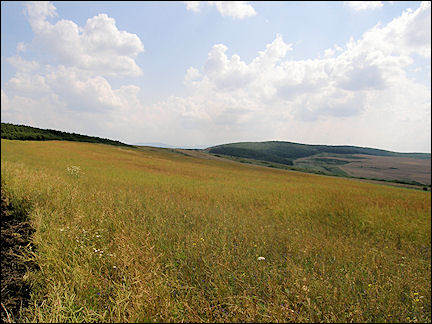
|
There are many unfinished buildings in the villages we pass through. And not just sheds and small houses, but even villas seem only half-built. Houses are painted in different colors, which makes for colorful views. Old men with weather- beaten faces sit on small benches in front of their houses, idly staring at passing traffic.
We see many churches even in the smallest villages. Some have onion-shaped steeples like the ones of the Kremlin, and grey, shiny sheets on their roofs. The asphalted road is in good condition. On the right side of the road are sturdy crash barriers, which cause a slight feeling of claustrophobia. We drive through a wooded area and see a dead wild boar. A little later we pass a dead badger.
We spend the night in a pensiunea in the quiet surroundings of Alba Iulia. There we also enjoy a copious dinner. A huge metal bowl with different kinds of cheese, tomatoes, several kinds of sausage, cucumbers, meatballs and cold breaded chicken schnitzels turns out to be only a first course. We are served a glass of "firewater" on the house and learn to say "cheers" in Romanian: noroc!
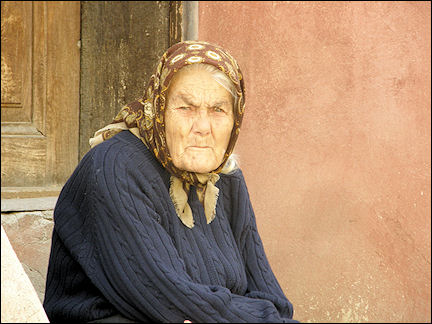
|
Then a soup tureen appears on the table, filled with boiling-hot beef soup with vegetables. The main course is a large dish of chicken legs, pork chops and baked potatoes. We wash everything down with tasty Romanian beer with the brandname Timişoreana.
The next morning it turns out that breakfast also is a substantial meal: different kinds of cold cuts and cheese, tomatoes, small cucumbers, fried eggs, large slices of thickly cut bread, coffee, tea and several kinds of soda.
Alba Iulia
The rent is paid in bags of grain
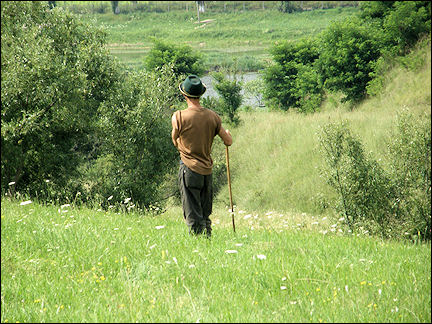
|
Near Sebeş a cousin of mine, who has been living in Romania for a couple of years already, gives us a tour of the land he works, which covers many hectares. We see hills with wheat, corn and rape.
Tractors and combines drive back and forth over the fields. A sinewy shepherd with a long stick in his hand is watching over a goat herd which grazes a fenced-in piece of sandy land with only a few sprigs of grass.
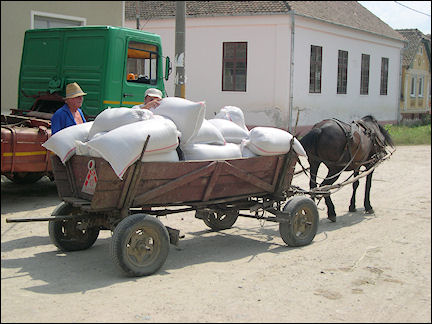
|
In the neighboring village of Reciu we witness the paymment of the rent: it is done with bags of grain. The grain is meticulously weighed and transferred into white bags. An old man with a mustache, a worn cowboy hat and a huge potbelly fetches his grain in a horse-drawn cart. The wooden cart has a triangular license plate on the back.
The road for through traffic is not asphalted and is riddled with potholes and rocks. The old houses have windows with metal or wooden shutters and some are painted in bright colors. They are connected by walls with tall gates which have their own doors.
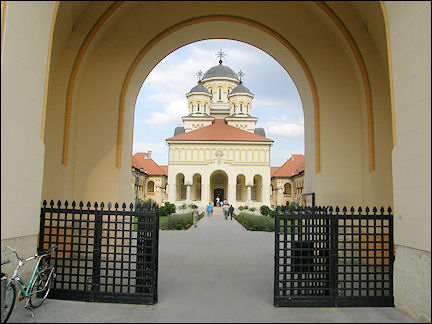
|
In the old town center of Alba Iulia we see the old city walls, partly overgrown with tall grass. The impressive orthodox cathedral dominates the town.
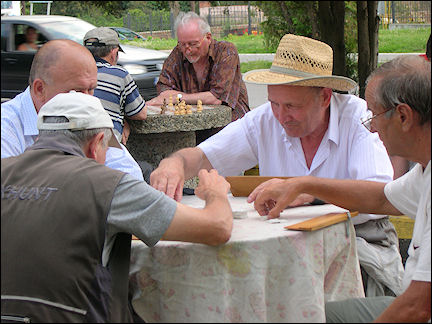
|
The large Roman Catholic church next to it is also pretty. On a large square elderly men sit in groups on wooden benches and play games: chess and several kinds of domino.
Alba has a guarded city gate: a young man in uniform with a bayonet on his long wooden gun stands guard. Now we feel safe!
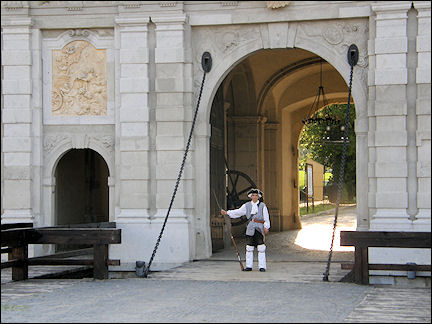
|
We see many stray dogs in the city. They are mostly mongrels who quietly go about their business and are not aggressive at all. They cross the street when you least expect it.
Târgu Mureş
There only is an old church in the citadel
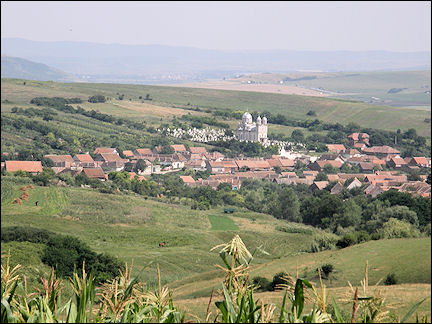
|
We drive from Alba Iulia to Târgu Mureş. We pass small villages with relatively big churches, which have beautifully shaped steeples.
Trees on the side of the road in villages and towns are painted white up to one and a half meters above the ground. Even in orchards we see this. Later we hear that Romanians feel this looks neat, but it is unclear to us if this explanation is true.
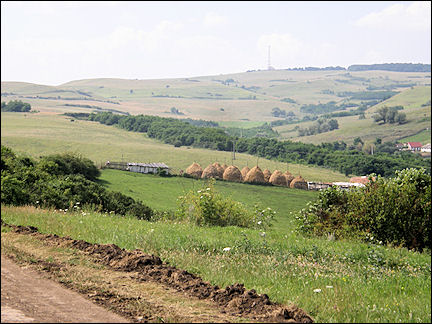
|
We see old women, dressed in black and wearing head scarves, working bent down in their gardens. A dead dog lies on the side of the road, its body swollen and its stiff legs in the air. A horse-and-wagon is holding up traffic.
Lots of people along the road are trying to hitch a ride: youngsters, workers, but also neatly dressed grannies with grandchildren. We see bicyclists riding their usually too small and rickety bikes on the side of the road. In the fields we see many small haystacks that sometimes look like halved Christmas bells, at other times like collapsed cooking pears with sticks.
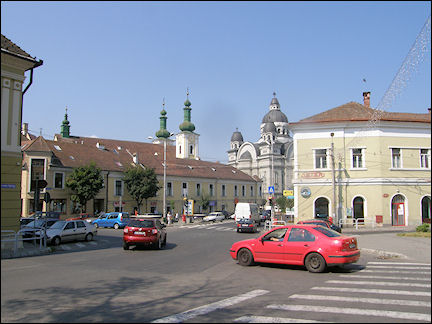
|
In Târgu Mureş we park our car in a side street in the town center and buy parking tickets. They look like scratch cards, on which you scratch the date and the time you want to park. At the center of the city is a park-like square, Piața Trandafirilor.
It is surrounded by tall old building with roofs covered with colorful, glazed roof tiles. There is a bronze statue of a she-wolf feeding two babies. They are Romulus and Remus, the mythical founders of Rome.
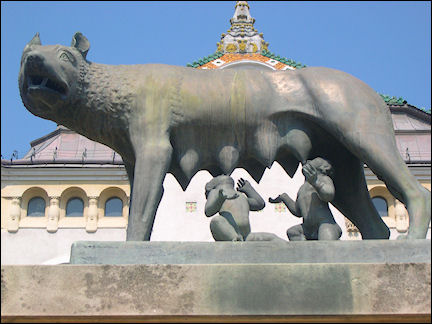
|
The statue is a present of the city of Rome (and a copy of the original one in that city), with which Târgu Mureş has historical ties. Ties that were used by the communist regime against the claims of Hungary: like the rest of Transsylvania, the city was part of Hungary until WWI.
A little outside the city center is the high-lying citadel with its walls. Inside is only one little church. Our teenage kids have seen enough of the city after two hours. We decide to keep the peace and spend the afternoon in the zoo, on the edge of the city. We see wolves, brown bears and lynxes in not too big, rusty cages.
Sighişoara
The medieval center is completely walled in
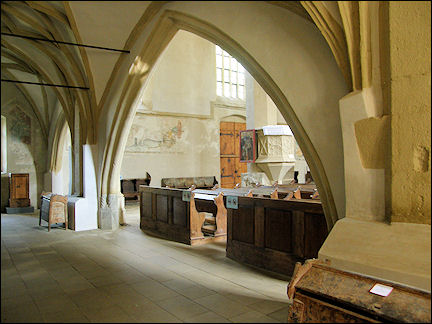
|
We continue on our trip to Sighişoara, the birthplace of Vlad Dracul. This blood-thirsty ruler, who ended the lives of his enemies in extremely unpleasant ways, served to some extent as a model for Bram Stoker's novel character Count Dracula.
A steep stone stairway, covered with wooden beams, leads to a high-lying mountain church, the Biserica din Deal. It is a simple but impressive building in Gothic style, the construction of which was started in 1345. The interior is very light, which makes it almost look modern.
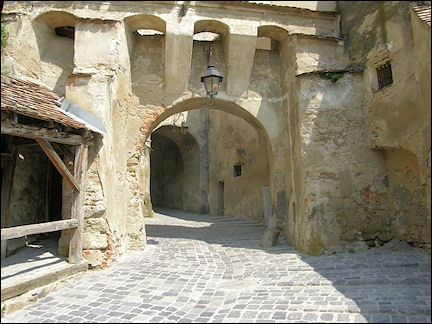
|
Outside we have a great view of the green hills and red roofs of the houses below us. The medieval center of Sighişoara is completely walled in and is Unesco Worl Heritage. We walk on bumpy cobblestone streets, passing through meters thick gates.
Large black street lanterns hang from yellow plastered walls. We see colorful store signs. There are many souvenir shops, which have masks, mugs, T-shirts, picture postcards and paintings.
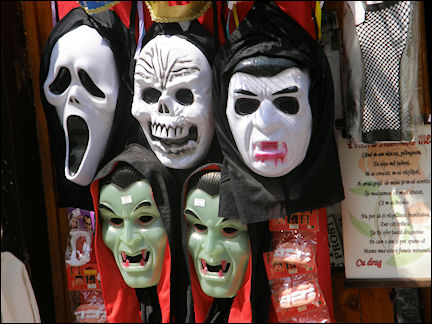
|
The next day a Medieval Festival wil begin, which will last for three days. Workers are building a stage of short, thick tree trunks and long wooden planks in the scorching sun.
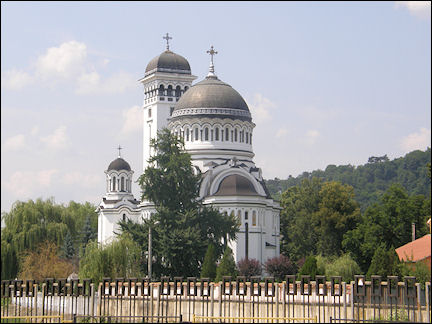
|
A happy-looking dog lies next to an outdoor café. Town criers, dressed in old-fashioned style, walk around an sing joyful songs in the languages of the tourists they meet.
We continue on to Biertan. When we are leaving Sighişoara we see a large white church with grey domes.
Biertan
A huge fifteenth-century church surrounded by double walls
Hundreds of long sticks stand on the hills, as soldiers in file. Later we see the same kind of sticks, but then they are supporting hop plants.
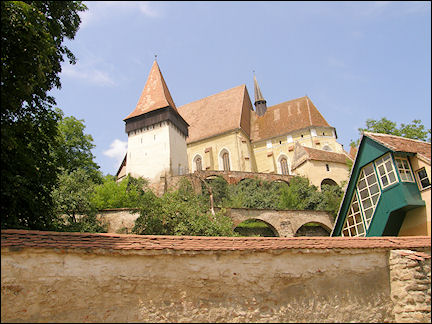
|
There are wooden stalls along the road with strings of garlic and onions. The onions hang from long sticks, like vertical abacuses. Sometimes there are just plastic tables in the shade of umbrellas, with carrots and tomatoes.
Meanwhile we are increasingly annoyed with the Romanians' feckless style of driving: after sitting on our tail for minutes, they pass us, even uphill and in turns, only to stay just ahead of us afterwards.W
The last part of the road to Biertan is riddled with potholes and leads along poor looking villages. The houses look neglected, their mud wall visible between the peeling paint. Our car is constantly escorted by swallows who fly just above the road, stay a few meters ahead of us and then suddenly fly up. Old women are selling redcurrants from buckets.
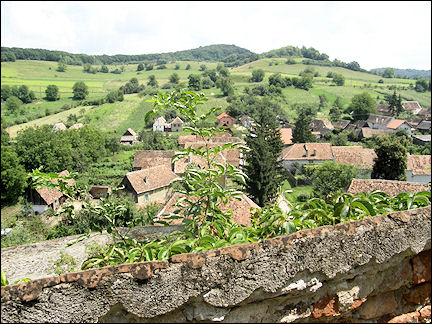
|
Biertan is dominated by a huge fifteenth century church surrounded by double walls.
Just like in Sighişoara a covered stairway leads to the church. The view is fantastic here as well, of the surrounding wooded hills and the red roof tiles, green with mold, on the roofs of the yellow houses.
Braşov
Brown bears live in the woods around the city
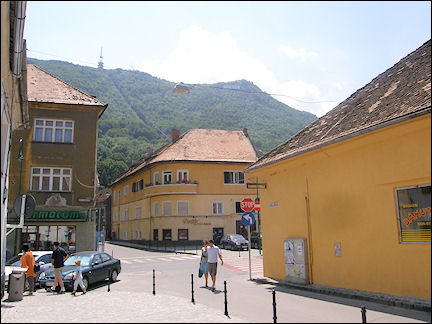
|
Braşov, where we arrive later that day, lies at the foot of one of the foothills of the Carpatian Mountains. High on the slopes of dark-green overgrown Mt. Tâmpa the name of the city is written in white letters. They have apparently studied how it was done in Hollywood. A cable-lift goes up there.
This time we want a place to stay outside a city and find a hotel near the touristic town of Bran; it actually has too many stars for the parents, but it is exactly right for the kids. A horde of tourists wanders through Bran, gaping at the fairy-like castle. The town has restaurants, pensiuneas and hotels all over the place.
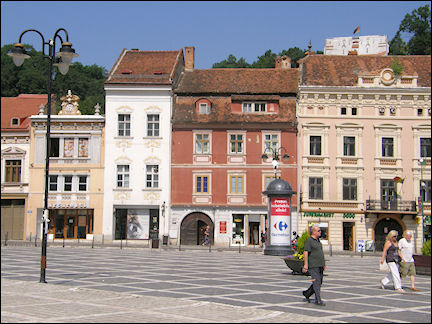
|
We return to Braşov, where we enjoy the views of promenading tourists on Piața Sfatului. This is a big square with lively outdoor cafés in the shade of umbrellas with the text "Probably the Best City in the World", the name of the city in Romanian, Hungarian and German.
This part of the country is clearly bilingual: we often hear people speak Hungarian and texts on signs and the like are both in Romanian and Hungarian.
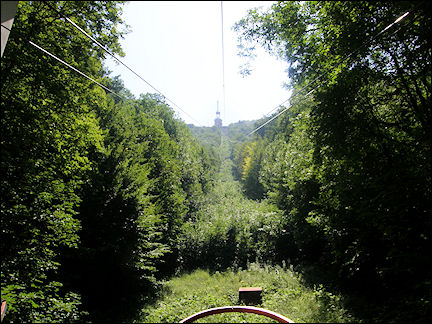
|
We take the cable-lift up. Only when we're there, it becomes clear how big the letters are on Mt. Tâmpa. Braşov also look beautiful from this altitude: the central square, the many churches, the red roofs, and the woods and hills surrounding it.
At the observation point my vertigo catches up with me: the drop is extremely sheer. The woods on the mountain are a nature reserve in which brown bears live. But we didn't see any during our walk.
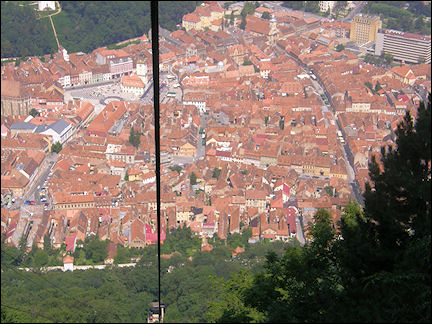
|
Just like in other cities in Romania, there are stark contrasts in Braşov. We pass luxury hotels (with even more stars than ours) in front of which too big and very expensive cars are parked.
But in the city center we see old women beg and also young gypsy women with children. In parks, on streets and squares we see several wedding parties, with festively dressed guests and the happy couples at the center.
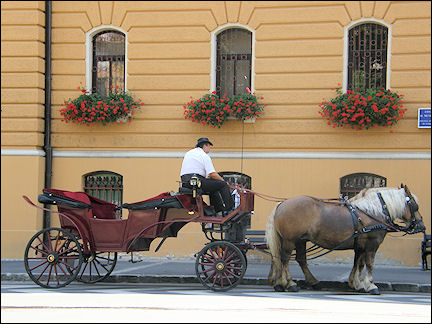
|
People are carrying one and a half meters long candles, to which flower bouquets are attached. Men in suits, who carry shiny gray umbrellas, take pictures and video tape the festivities. Somewhere else, a coach with two horses and a coachman is waiting for a bridal couple.
Piteşti
Stalls with pretzels, lemonade, blackberries and raspberries
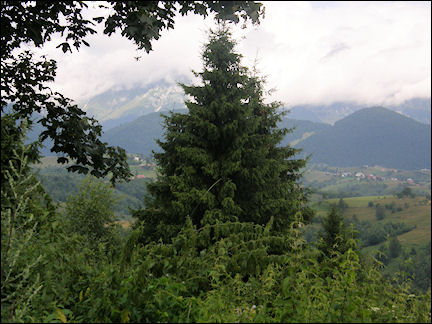
|
The weather is changing. At some point the sun, which has been shinging for days on end, disappears completely and is replaced with dark clouds. It starts to rain and the temperature drops quickly.
We drive to Piteşti, via Câmpulung. A fantastically beautiful route. High mountains with pines in the distance, hills with low-lying villages, shiny church steeples, hairpin turns.
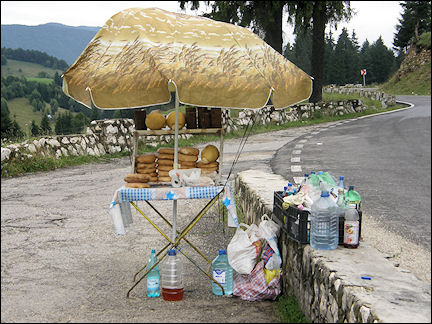
|
There is a surprise after every turn. On the side of the road we see stalls with big salty pretzels, bottles of lemonade syrup, blackberries, raspberries and other kinds of berries.
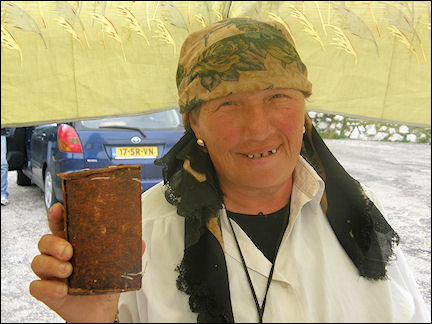
|
A gypsy woman with gleaming silver teeth and a headscarf wound tightly around her head, sells pungent, dark-brown sheep's cheese.
The low clouds and patches of fog begin to obscure the views. We take a secondary road and drive through villages where times has stood still. Teethless men sit on benches in front of trheir houses and chat. Large white and brown chickens roam in the tall grass and around the houses; hissing geese stare angrily at us.
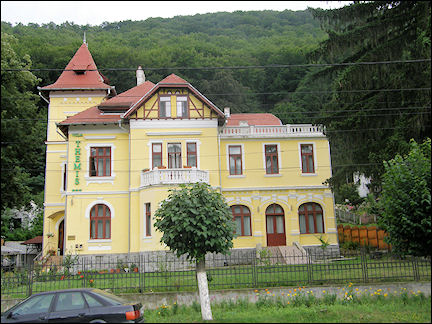
|
A brook with large rocks in it gurgles down. The asphalted road ends and instead we find ourselves on a gravel path. The village is not on the map and we don't know exactly where the path will take us, so we turn.
We take a different road and end up in Călimăneşti-Căciulata. This town, famous for its thermal baths, appears to be nothing more than a busy through-road with large villas, restaurants and hotels on both sides. The lower parts of the trees are also painted white here.
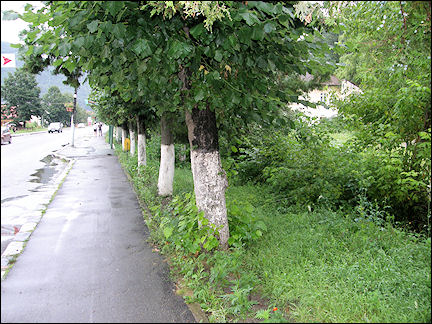
|
From our large room in a villa we have a view of dark hills and high mountains behind them. A calm river, the Olt, flows parallel to the road. Behind it are the railway tracks and behind those is a road for trucks. In one of the restaurants by the river we have an ice-cold Ursus beer, until the deafeningly loud music chases us away.
Sibiu
Old women are chatting in the middle of the road
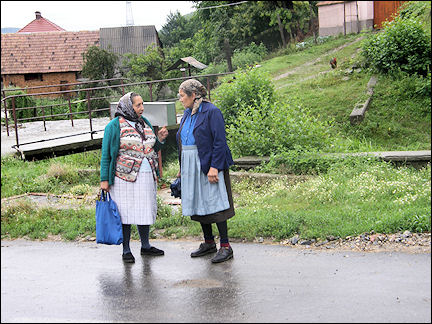
|
We take road #7 to Sibiu, a 70 kilometers drive. To our left is a steep wall of rock, to our right the Olt river. For a while, the train tracks run parallel to the river. The river banks are covered with concrete, which makes the rivel look like a canal. In the distance we see a large dam.
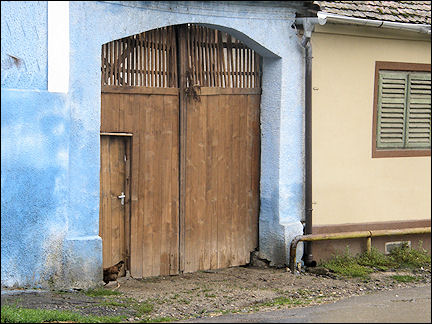
|
The hills look like those of a model railway: grainy and green, with trees that seem each individually planted on the slopes. We take a wrong turn and end up in a small village at the end of the road. We disturb the serene quiet with our car. Old women are chatting in the middle of the road.
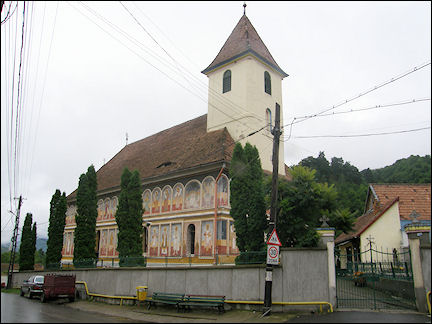
|
A little girl with pitch-black curls, dressed in a faded grey dress, is playing in an improvised sandbox against a fence. A horse-drawn cart moves tantalizingly slow over the cobblestones. A large brown chicken roams near the gate of a house. There is a beautiful church, lavishly painted on the outside.
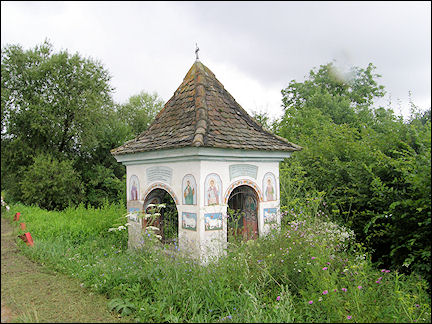
|
In the shepherds village of Răsinari we see some little prayer houses with pretty, fresh and colorful frescoes. In several places in the village lie rusty train or streetcar tracks, crisscrossing the roads.
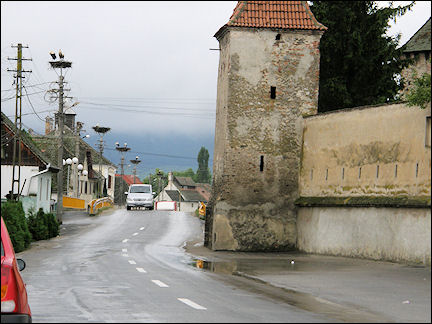
|
We pass through Christian, which is called the stork village for a good reason. Along the through-road stand electricity poles, almost all of them supporting storks' nests. We see dozens of these birds, rattling on the roofs, standing on their nests and flying over the church.
In Sibiu we spend the night in an apartment in a large, grand building in a quiet and shadowy street, next to the German Consulate. It is only a few minutes' walk to the city center.
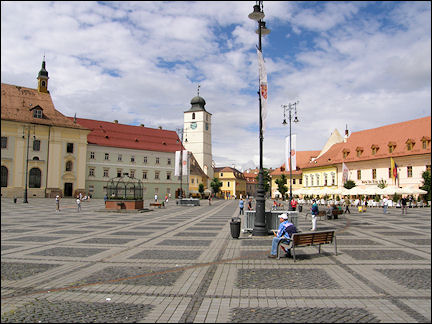
|
We first have to cross a busy road, with a pedestrian crossing, but without traffic lights. But all cars stop. We walk through a gate in the city walls, which has three towers, and via the promenade Strada Nicolae Bălcescu we arrive on the square Piața Mare.
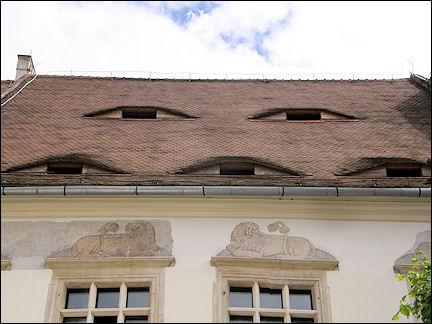
|
The square is enormous, with just a few benches and lots of pigeons. It is surrounded by colorful buildings, restaurants, a church and outdoor cafés. Some of the roofs, covered with faded red roof tiles, have typical "eyelid attic windows".
We see many of those attic windows all over the city. It is as if the buildings are constantly keeping an eye on us and allow us with a wink to explore their beautiful city.
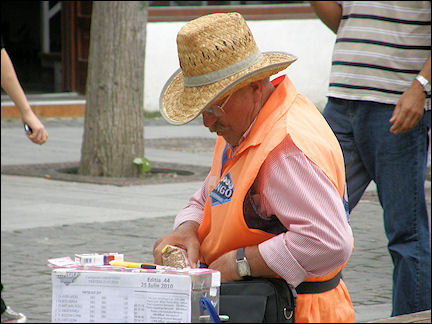
|
The weather improves, the sun appears and the temperature feel comfortable again. Little boys run over the Piața Mare to chase away the many pigeons. Tourists walk hand in hand, eating ice cream. Others gaze at the splendid gables of the buildings, have drinks in an outdoor café or take pictures of each other.
A group of Latin-American musicians is about to perform. A man in a straw hat sits on the square and sells lottery tickets.
Şandra
Back to the Hungarian border
We drive via Făget and Lugoj to Timişoara. The landscape here is less interesting than what we saw before, it is also much more level.
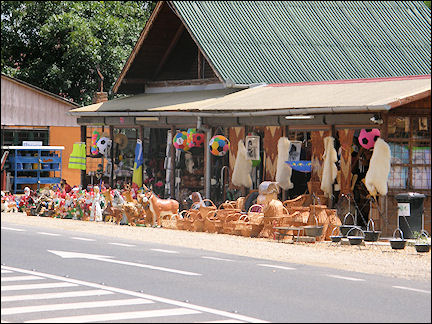
|
In several villages we see houses with a special kind of Dutch gables, covered with glazed tiles. In Recaş are huge villas with columns in the front. Along the road people sell wicker baskets, large garden gnomes and plastic animals, like deer and storks.
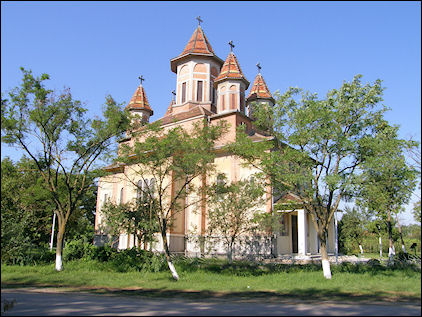
|
We spend the night in Şandra, less than 50 kilometers from the Hungarian border. Because of a power failure in the pensiunea, dinner is somewhat disappointing. Luckily the Ursus beer is still wonderfully cool. Noroc! Via Lovrin, where we take one last picture of a pretty church, we drive back to the Hungarian border.